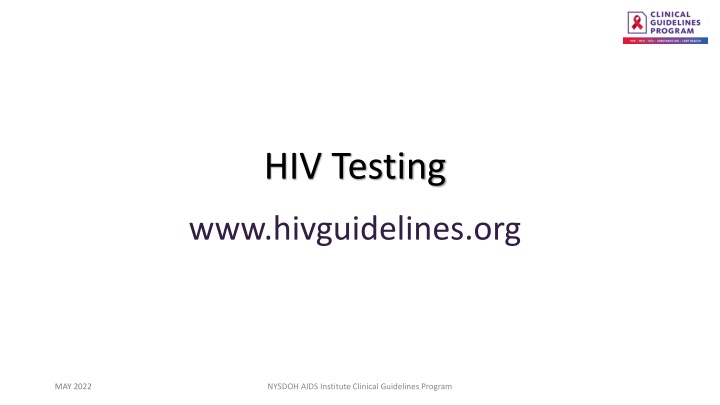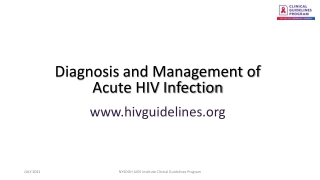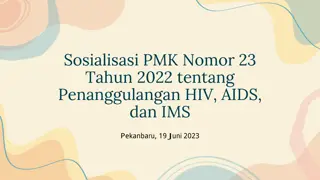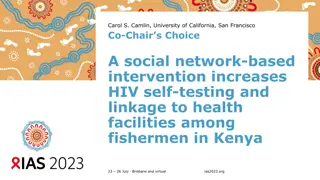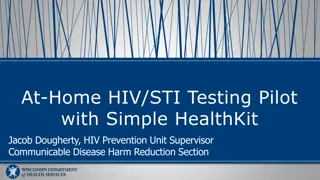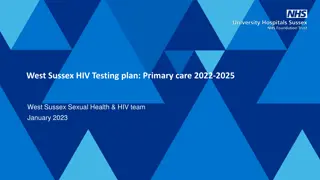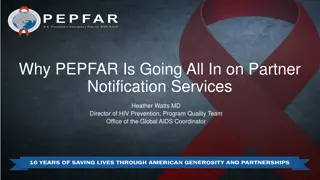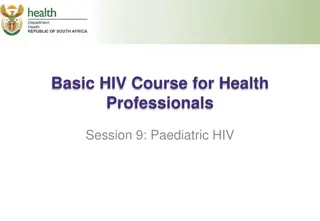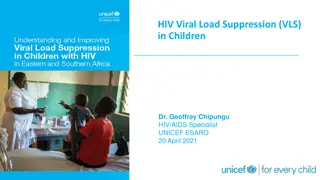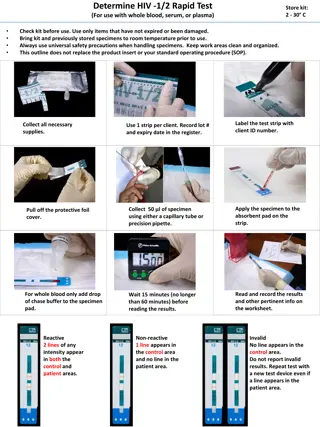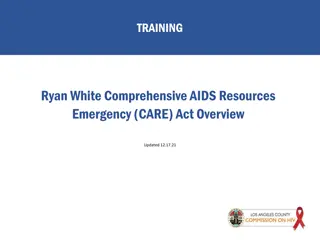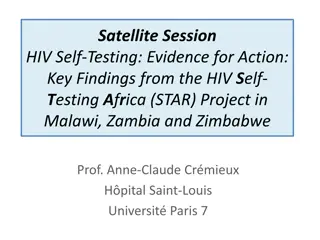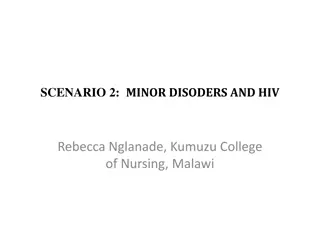HIV Testing
This guideline provides clinicians in New York State with updated information on HIV testing policies and practices. It emphasizes the standard 3-step HIV testing algorithm recommended by the CDC and NYSDOH AI, aiming to increase HIV testing rates and prompt referrals for appropriate care. Clinicians must adhere to NYS HIV/AIDS laws and regulations, including reporting confirmed cases of HIV. The document also outlines the time to HIV detection, HIV test window, and the standard HIV laboratory testing algorithm.
Download Presentation

Please find below an Image/Link to download the presentation.
The content on the website is provided AS IS for your information and personal use only. It may not be sold, licensed, or shared on other websites without obtaining consent from the author.If you encounter any issues during the download, it is possible that the publisher has removed the file from their server.
You are allowed to download the files provided on this website for personal or commercial use, subject to the condition that they are used lawfully. All files are the property of their respective owners.
The content on the website is provided AS IS for your information and personal use only. It may not be sold, licensed, or shared on other websites without obtaining consent from the author.
E N D
Presentation Transcript
HIV Testing www.hivguidelines.org MAY 2022 NYSDOH AIDS Institute Clinical Guidelines Program
Purpose of This Guideline Purpose of This Guideline Provide clinicians in NYS with up-to-date information on HIV testing policies and practices. Ensure awareness of and access to the standard 3-step HIV testing algorithm recommended by the CDC and the NYSDOH AI. Increase HIV testing in NYS to increase the number of people who know their HIV status. Ensure that clinicians recognize and respond to HIV testing as a gateway to care, such that an HIV diagnosis prompts a referral for HIV treatment and a negative HIV test result prompts a referral for HIV prevention services, including pre- and post-exposure prophylaxis (PrEP and PEP). Emphasize that rapid ART initiation is the standard of care for all individuals diagnosed with HIV. Provide clinicians with information about the Wadsworth Center Bloodborne Viruses Laboratory services. MAY 2022 NYSDOH AIDS Institute Clinical Guidelines Program www.hivguidelines.org
New York State Law and Testing Requirements New York State Law and Testing Requirements Clinicians must perform diagnostic HIV laboratory tests in full compliance with NYS HIV/AIDS Laws and Regulations. Clinicians must report confirmed cases of HIV according to NYS law (see NYSDOH Provider Reporting and Partner Services). Additional information regarding testing procedures and regulations is available from the NYSDOH Wadsworth Center (518-474-2163). See full guideline for list of NYS Public Health Law HIV Testing Requirements (effective June 2018). MAY 2022 NYSDOH AIDS Institute Clinical Guidelines Program www.hivguidelines.org
Time to HIV Detection Time to HIV Detection Eclipse period: Time following an HIV exposure during which no available HIV test can detect the virus. Median length: 11.5 days Window period: Period between an HIV exposure and when a test can detect HIV. Duration varies by person, test, and use of antiretrovirals as PrEP or PEP. MAY 2022 NYSDOH AIDS Institute Clinical Guidelines Program www.hivguidelines.org
HIV Test Window HIV Test Window of Detection of Detection Notes: a.Figure reproduced from CDC: HIV Diagnostic Tests. b.Without PrEP or PEP exposure; PrEP or PEP exposure may delay seroconversion. Very early treatment of acute HIV infection may also alter the serologic response. MAY 2022 NYSDOH AIDS Institute Clinical Guidelines Program www.hivguidelines.org
Standard HIV Laboratory Testing Algorithm Standard HIV Laboratory Testing Algorithm Notes: a. Adapted from CDC 2018 Quick reference guide: Recommended laboratory HIV testing algorithm for serum or plasma specimens and APHL Suggested reporting language for the HIV laboratory diagnostic testing algorithm. b. APHL and CDC continue to recommend that laboratories use an FDA-approved instrumented HIV-1/HIV-2 Ag/Ab immunoassay as the initial assay in the laboratory HIV testing algorithm for serum or plasma due to their superior sensitivity for detecting acute HIV infection. However, the FDA-approved single-use rapid HIV-1/HIV- 2 Ag/Ab immunoassay may be used as the initial assay in the laboratory HIV testing algorithm for serum or plasma if an instrumented assay is not available. c. Become familiar with the laboratory's internal testing algorithm and results-reporting policies. Many labs will reflex additional screening steps (such as HIV Ab differentiation immunoassay and HIV RNA) on the original sample without supplemental orders. Other labs may require additional samples or supplemental orders to complete all steps in the algorithm. d. This includes specimens reported as HIV-2 positive with HIV-1 cross-reactivity. e. Further testing may be performed to determine type. f. Per the Geenius package insert, specimens with this final assay interpretation should be retested with a new cartridge. If the final assay interpretation is again HIV-2 indeterminate, it should be reported as such and followed with an HIV-1 NAT. g. Most laboratories reflex directly to an HIV-1 RNA test without requiring an additional test order or new specimen, either by performing the test in-house or referring the specimen to another laboratory. If the laboratory is unable to or does not automatically reflex directly to the RNA test, clinicians should order an HIV-1 RNA test as soon as possible. To reflex directly to an HIV-1 RNA test, a test kit approved by either the FDA or NYSDOH to aid in diagnosing HIV-1 infection is required. If HIV-1 RNA is detected, acute HIV-1 is present, and clinicians should proceed with clinical evaluation. If no HIV-1 RNA is detected, the initial immunoassay result is presumed false positive. h. A negative HIV-1 NAT result and repeatedly HIV-2 indeterminate or HIV indeterminate antibody differentiation immunoassay result should be referred for testing with a different validated supplemental HIV-2 test (antibody test or NAT) if available. Alternatively, redraw and repeat algorithm in 2 to 4 weeks to assess HIV-2 infection. MAY 2022 NYSDOH AIDS Institute Clinical Guidelines Program www.hivguidelines.org
Recommendations: HIV Testing Recommendations: HIV Testing With the Standard 3 With the Standard 3- -Step Algorithm Step Algorithm Step 1: HIV-1/2 Antigen/Antibody Immunoassay For initial HIV testing (aka screening ), clinicians should use an HIV-1/2 Ag/Ab immunoassay (formerly known as the 4th-generation test). (A2) For initial testing of newborns or individuals who are in labor, being evaluated for PEP, or unlikely to return for test results, clinicians should use an FDA-approved HIV screening test that provides results within 60 minutes (A2); otherwise, rapid tests are not recommended for step 1 of the standard HIV laboratory testing algorithm. Because all initial HIV tests are subject to false positive results, clinicians should consider all reactive initial test results preliminary and perform appropriate laboratory diagnostic testing to confirm a patient s HIV status. (A1) Clinicians should educate patients about the limitations of in-home testing and emphasize that a laboratory should repeat both nonreactive and reactive results of any in-home HIV testing. (A3) In the case of a nonreactive result, the clinician should discuss goal-oriented, harm-reduction strategies, including PrEP and emergency PEP, with any patient who reports recent or likely ongoing HIV risk exposures or refer the patient for prevention services. (A3) Clinicians should offer repeat HIV testing every 3 months, or sooner if acute HIV is suspected, for as long as an individual remains at high risk of HIV exposure. (A3) MAY 2022 NYSDOH AIDS Institute Clinical Guidelines Program www.hivguidelines.org
Recommendations: HIV Testing Recommendations: HIV Testing With the Standard 3 With the Standard 3- -Step Algorithm Step Algorithm, ,continued continued Step 2: HIV-1/HIV-2 Antibody Differentiation Immunoassay Per the standard HIV laboratory testing algorithm, if a reactive result is obtained with an HIV-1/2 Ag/Ab immunoassay test (step 1), clinicians should perform supplemental testing (step 2) with an FDA-approved HIV- 1/HIV-2 Ab differentiation immunoassay. (A1) If the result of the HIV Ab differentiation immunoassay (step 2) is positive for HIV-1 or HIV-2 Abs, the clinician should provide or refer the patient for rapid ART initiation and transmission prevention counseling. (A1) Note: If the HIV Ab differentiation immunoassay result is positive but undifferentiated (i.e., reactive for both HIV-1 and HIV-2), repeat testing may determine if the patient has HIV-1 or HIV-2 infection. MAY 2022 NYSDOH AIDS Institute Clinical Guidelines Program www.hivguidelines.org
Recommendations: HIV Testing Recommendations: HIV Testing With the Standard 3 With the Standard 3- -Step Algorithm Step Algorithm, ,continued continued Step 3: HIV-1 Nucleic Acid Testing (qualitative or quantitative HIV RNA testing) If the HIV-1/2 Ab differentiation immunoassay (step 2) result is nonreactive (negative) or indeterminate (neither positive nor negative for HIV-1 or HIV-2), and the lab does not perform reflex testing, the clinician should immediately order HIV-1 RNA NAT (step 3) to detect the presence of HIV-1 RNA and confirm or exclude HIV-1 infection. (A*) If HIV-1 RNA is detected, the clinician should inform the patient of the acute HIV- 1 diagnosis, recommend ART initiation, and prioritize counseling to prevent HIV transmission. (A1) Clinicians should not wait for serologic confirmation of HIV to initiate ART when pregnant individuals are diagnosed with acute HIV infection by HIV-1 NAT; initiation of ART is strongly recommended for pregnant individuals. (A2) To determine the HIV status of an infant born to an individual with HIV-1, clinicians should perform HIV-1 RNA NAT. (A1) MAY 2022 NYSDOH AIDS Institute Clinical Guidelines Program www.hivguidelines.org
HIV Testing Services and Assistance Available HIV Testing Services and Assistance Available Through the NYSDOH Wadsworth Center Through the NYSDOH Wadsworth Center HIV-1/HIV-2 Diagnostic Testing (Phone: 518-474-2163) HIV-1/2 Ag/Ab testing; plasma and serum HIV-1/HIV-2 supplemental Ab testing of specimens that are reactive on the initial testing assay HIV-1 RNA testing on plasma, serum, and dried blood spots HIV-2 NAT to quantify HIV-2 RNA Assistance with inconclusive HIV test results Confirmatory testing of dried blood spots for HIV testing sites that cannot collect venous blood HIV Testing for Newborns (Phone: 518-486-9605) HIV testing for all newborns exposed to HIV (HIV-1 and HIV-2) in NYS, free of charge If a sample is reactive for HIV-2 antibodies, the Pediatric HIV Testing Service will perform an RT-PCR test for qualitative detection of HIV-2 RNA NYSDOH strongly recommends that all NYS birth facilities use the Pediatric HIV Testing Service at the Wadsworth Center, which is free of charge for NYS clinicians providing care for HIV-exposed infants HIV-2 Viral Load Testing (Phone: 518-473-6007) Quantitative and qualitative HIV-2 viral load testing (free of charge), and quantitative detection of HIV-2 RNA in plasma samples for baseline and subsequent monitoring of response to ART in patients with confirmed HIV-2 infection HIV-2 RNA viral load testing during pregnancy. Contact the lab early in the patient s pregnancy to discuss the protocol and timing for testing MAY 2022 NYSDOH AIDS Institute Clinical Guidelines Program www.hivguidelines.org
Key Points Key Points HIV-1/2 Antigen/Antibody Immunoassay (Step 1) Become familiar with the laboratory s internal testing algorithm and results-reporting policies. Many labs will reflex additional screening steps (such as HIV Ab differentiation immunoassay and HIV RNA) on the original sample without supplemental orders. Other labs may require additional samples or supplemental orders to complete all steps in the algorithm. When possible, collect blood by venipuncture for laboratory submission. Consult the specimen collection and handling instructions provided by the laboratory to ensure the specimen will be suitable for all tests in the algorithm. As seroconversion proceeds and HIV Abs are produced, p24 is bound in an Ag-Ab complex and becomes more difficult to detect by standard laboratory assays. Serologic assays that detect only p24 Ag are not recommended for any diagnostic purpose and are not available at most clinical laboratories. NYSDOH strongly recommends that all NYS birth facilities use the Pediatric HIV Testing Service at the Wadsworth Center, which is free of charge for NYS clinicians providing care for HIV-exposed infants. For information about this service, contact the Wadsworth Center at 518-486-9605. MAY 2022 NYSDOH AIDS Institute Clinical Guidelines Program www.hivguidelines.org
Key Points Key Points HIV-1/HIV-2 Antibody Differentiation Immunoassay (Step 2) If the Geenius HIV 1/2 Supplemental Assay interpretation is nonreactive or indeterminate for any HIV type (HIV-1, HIV-2, or untypable HIV), test the specimens for HIV-1 RNA, even if the result is HIV-2 indeterminate. Nonspecific reactivity could cause an HIV-2 indeterminate result to occur in some cases. If HIV-1 RNA is not detected and the Geenius Reader interpretation is HIV-2 indeterminate or HIV indeterminate, an HIV-2 NAT may be warranted. HIV-1 RNA Nucleic Acid Testing (Step 3) If the person being tested is taking antiretroviral agents as PEP, PrEP, or for rapid ART initiation, a false negative result for the HIV-1 RNA test may occur. MAY 2022 NYSDOH AIDS Institute Clinical Guidelines Program www.hivguidelines.org
Recommendation: Diagnosis of HIV Recommendation: Diagnosis of HIV- -2 Infection 2 Infection When HIV-2 antibodies are detected, clinicians should perform a clinical evaluation for HIV-2 infection that is similar in scope to the evaluation of patients with HIV-1. (A1) MAY 2022 NYSDOH AIDS Institute Clinical Guidelines Program www.hivguidelines.org
HIV Immunoassays Available in NYS HIV Immunoassays Available in NYS FDA-Approved HIV-1/2 Ag/Ab Immunoassays Abbott ARCHITECT HIV Ag/Ab Combo (Abbott Laboratories) ADVIA Centaur HIV Ag/Ab Combo (CHIV) Assay (Siemens Healthcare Diagnostics) BioPlex 2200 HIV Ag-Ab Assay (Bio-Rad Laboratories) GS HIV Combo Ag/Ab EIA (Bio-Rad Laboratories) Elecsys HIV combi PT (Roche Diagnostics) VITROS Immunodiagnostic Products HIV Combo (Ortho-Clinical Diagnostics) FDA-Approved HIV Rapid Tests Chembio SURE CHECK HIV 1/2 Assay (Chembio Diagnostic Systems) Chembio DPP HIV 1/2 Assay (Chembio Diagnostic Systems) Chembio HIV 1/2 STAT-PAK Assay (Chembio Diagnostic Systems) Abbott Determine HIV-1/2 Ag/Ab Combo (Abbott) INSTI HIV-1/HIV-2 Antibody Test (bioLytical Laboratories) OraQuick ADVANCE Rapid HIV-1/2 Antibody Test (OraSure Technologies) Uni-Gold Recombigen HIV-1/2 (Trinity Biotech) MAY 2022 NYSDOH AIDS Institute Clinical Guidelines Program www.hivguidelines.org
Need Help? Need Help? NYSDOH AIDS Institute Clinical Guidelines Program www.hivguidelines.org
Access the Guideline Access the Guideline www.hivguidelines.org > HIV Testing Also available: Printable pocket guide and PDF NYSDOH AIDS Institute Clinical Guidelines Program www.hivguidelines.org
